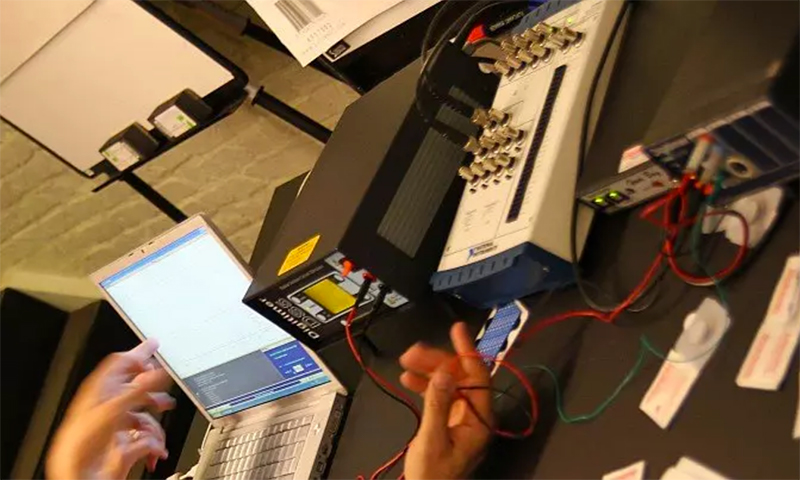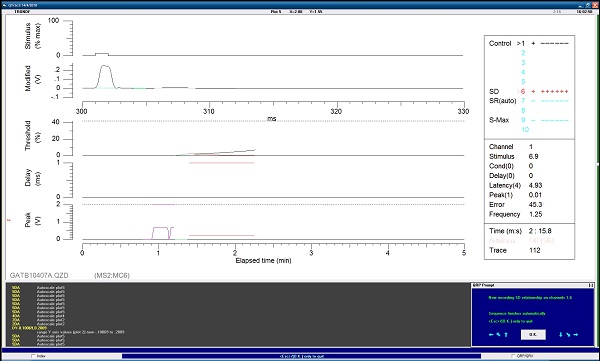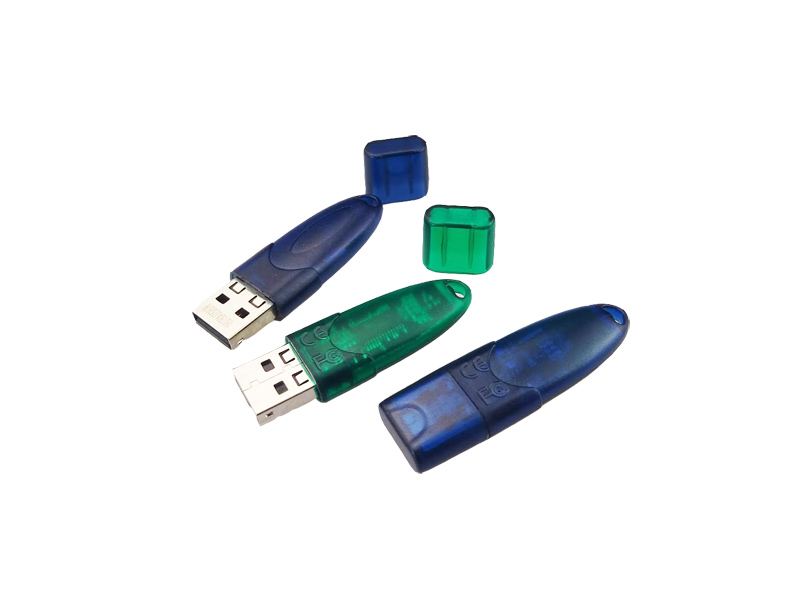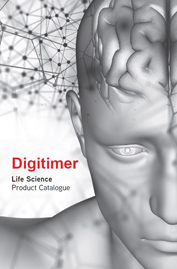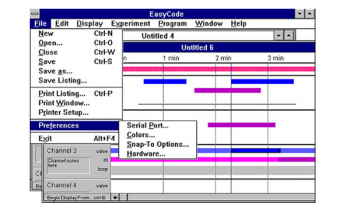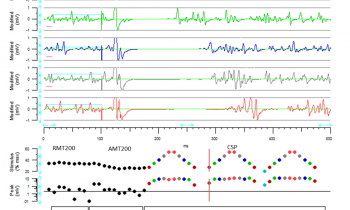Description
DESCRIPTION
Introduction to QtracW Threshold Tracking Software
QtracW Threshold Tracking Software is a flexible, stimulus-response data acquisition program with averaging, threshold-tracking and latency-tracking facilities, originally written for studies of human nerves in vivo, but also used for microneurography, muscle excitability testing and cortical excitability testing with transcranial magnetic stimulation.
It is most appropriate for experiments in which the excitability or response of the preparation varies slowly with time, either due to programmed changes in the stimulus or to an externally initiated treatment, and the data of primary interest are the changes in selected parameters (threshold, amplitude, latency, etc.) of the response with time. All or selected raw response waveforms can also be recorded, enabling the time course of additional response parameters to be calculated after the recording is finished. QTrac (which became QtracW when adapted for Windows) comprises separate stimulation and plotting programs, QTracS and QTracP, both written in Visual Basic 6.0, which have the same mode of operation and share many of the same facilities.
The Digitimer DS5 Bipolar Constant Current Stimulator was specifically designed to work with QtracW software for human studies of nerve/muscle excitability. The major components of a human nerve excitability setup include a PC running QtracW software, a nerve stimulator (e.g. Digitimer DS5), an isolated EMG amplifier (e.g. Digitimer D440-2) and a compatible DAQ interface. We also strongly recommend the Digitimer Humbug Noise Eliminator or D400-2/D400-4 to remove mains interference, as many QtracW systems are mobile and used in electrically noisy hospital environments. For animal-based studies, our DS4 Biphasic Stimulator is a suitable alternative to the DS5 and compatible with QtracW.
Recent updates to the QtracW software have added a feature that allows continuous skin temperature monitoring when a compatible temperature monitor is used. Digitimer has developed the new D501 Isolated Temperature Monitor for this purpose.
For those unfamiliar with the application of QtracW software in studies of nerve excitability, we recommend the recent article by Prof. Matthew Kiernan and colleagues (Kiernan et al. 2020), which provides guidelines for the measurement of axonal excitability and provides a state of the art review of axonal excitability research.
Compatible DAQ Hardware
National Instruments DAQ interfaces are recommended for use with QtracW software (see below). Please consult the QtracW users manual for the latest details on specific models.
Obtaining QtracW
QtracW software can be freely downloaded from here. A ZIP file contains subfolders for new installations and updates. After 50 days of evaluation QtracW will only function through the use of a USB hardware dongle/key which is provided once a licence has been purchased from Digitimer. All new licences are activated for a minimum of 3 years.
Installation Instructions
All the necessary files and installation instructions are included in the zip archive linked above. Please ensure the “Read Me First” text file is read prior to installation.
QtracW Training
A series of highly successful nerve excitability workshops have been held between 2009 and 2023. Further workshops may be organised in the future if there is adequate demand. Please contact us if you are interested in attending a workshop and we can put you in touch with the organisers if any are planned.
Purchasing QtracW
New QtracW users need to purchase a 3 year licence pack from Digitimer, with non-commercial academic and clinical users receiving a 50% discount from the full list price of £4,000.
This initial pack consists of one QtracSP dongle (stimulation and analysis/plotting) and two QtracP (analysis/plotting only) dongles. Once a user becomes a registered QtracW licensee, further dongles can be purchased individually with variable lifetimes (one to five years) and capabilities (either QtracP or QtracSP).
Additional USB Dongles and Licence Extensions for Existing Users
Registered users can purchase additional dongles or extend the lifetime of an existing dongle by paying the appropriate licence fee. Existing QtracW users can also transfer licence time from a dongle to their computer using a new “dongle internalisation” feature. Please contact Digitimer for further details.
Hardware & Software Requirements
QtracW can be used with PCs running Windows 10. (QtracW may also be used on a Mac, if Parallels is used to install Windows and a Windows keyboard is added.)
QtracS currently supports the following data acquisition cards/units:
- PCI: PCI-6221M (National Instruments) (All Qtrac functions)
- PCMCIA: DAQCard-6062E (National Instruments) (Digital o/p not supported)
- USB: USB-6221, USB-6251 (NI) (All Qtrac functions)
- USB-6341 (National Instruments) (All Qtrac functions)
- Micro-1401 (Cambridge Electronic Design) (Digital o/p not supported)
- Power-1401 (Cambridge Electronic Design) (Digital o/p not supported)
Motor Unit Number Estimation (MUNE) – MScanFit
Compound muscle action potential (CMAP) scans are detailed stimulus-response curves which provide information about motor unit properties in neuromuscular disorders. Available from the QtracW download page, MScanFit is a freeware program which is described in the paper ‘Estimating motor unit numbers from a CMAP scan’ (Bostock, 2015). The program works by generating a motor unit model to account for a detailed stimulus-response curve or CMAP scan obtained using QtracW protocols. Full details of the assumptions, the generation of a preliminary model, and the method of refining the model to improve the fit to the recorded CMAP scan can be found in that paper.
QTMS Cortical Excitability Protocols for Solo TMS Operators
QtracW is increasingly being used for microneurography, muscle excitability testing and cortical excitability testing with transcranial magnetic stimulation. Although control of magnetic stimulators has been possible for several years under standard QtracS protocols, Prof. Hugh Bostock and his colleagues at QTMS Science Ltd. have recently launched a new QTMSG recording suite specifically aimed at TMS users, allowing a solo operator to run QtracW TMS protocols and obtain standardized recordings automatically. Please see our QTMS product page for further details.
GALLERY
DOWNLOADS
Product Information
QtracW Software
QtracW Operator’s Manual
Typical Equipment Setup for DS5/QtracW Installation
References
Publications which cite use of QtracW can be found on Google Scholar.
